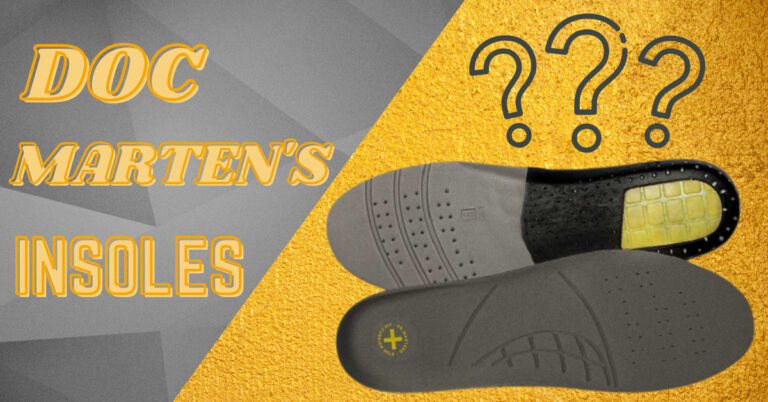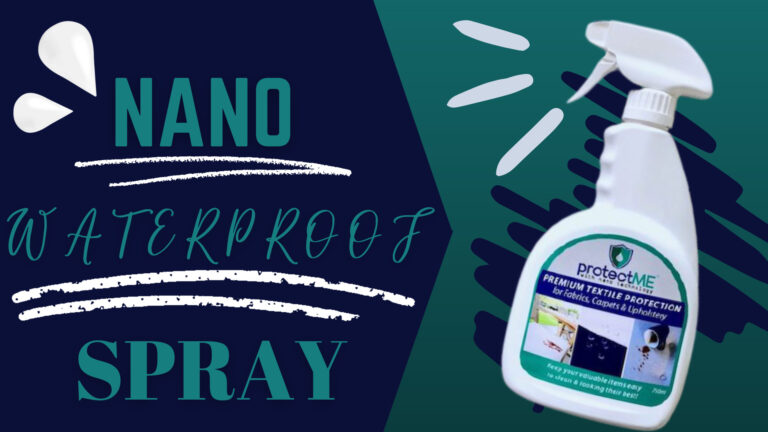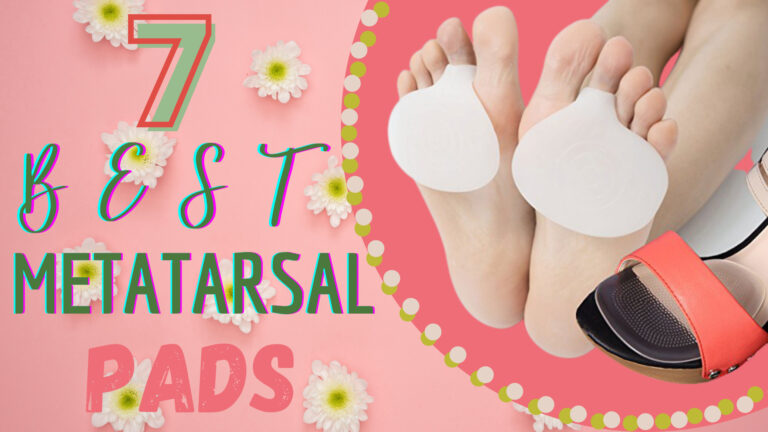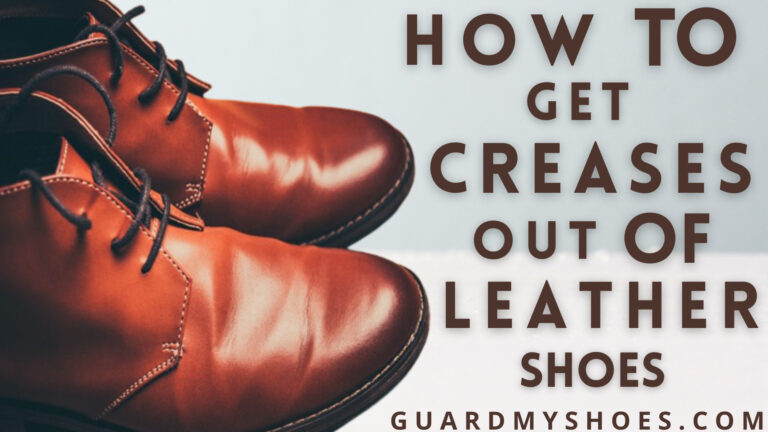How to Make Shoes Waterproof – DIY Methods With Wax, Spray & Oil
Having your shoes damaged after a hike, or just a walk, in the rain, or getting your feet wet and cold every time you go out in autumn or winter can be a real setback and disappointment. Unfortunately, not all the shoes come waterproofed, but fortunately, there is absolutely no need to settle for the lack of necessary protection; you can build the guard yourself.
There are multiple ways to make your non-waterproof shoes waterproof. The prospect of walking in the rain and going out in winter without the fear of the water seeping into my shoes got me relieved and excited when I came to know about that. Feel free to let the same feelings get to you.
I have elaborated on those methods to make your shoes waterproof in this article, all the important knowledge, and tips. Those include using wax, waterproofing spray, and oil to give water-repellency to your shoes. Along with that, there are 3 tried and recommended products, one for each of the three methods. So, go through this article and hopefully by the end you will have the decision made, about what way you should go with.
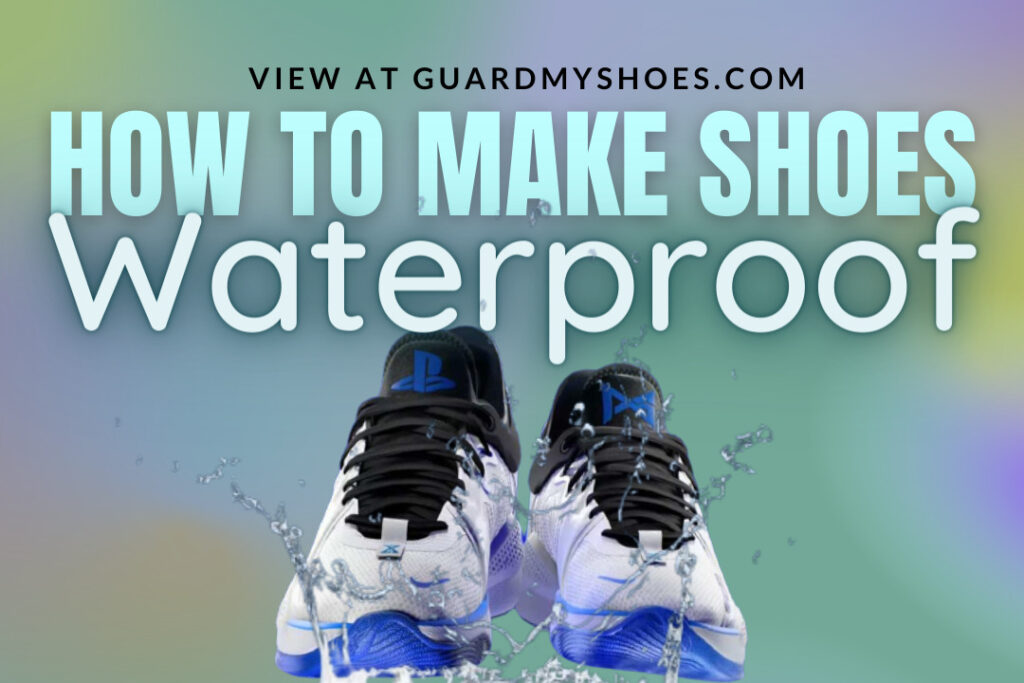
How to Make Shoes Waterproof
There are 3 popular ways that are used to make the shoes waterproof, wax, spray, and oil. While the property of waterproofing remains the same, there are some variations between these methods, depending on the longevity and performance, and also the material they are ideal for. Let’s explore the details of each of these methods below.
1. Using Wax
Wax is the best method to waterproof shoes because it lasts the longest of all. It works brilliantly to waterproof the shoes, both leather, and cloth, and keeps the shoes dry and protected for the longest time than any other method. The only drawback with using wax is that the application is difficult, and it needs a hairdryer to set the wax in the shoe.
The wax you use should not be dyed and scented, or it can stain your shoes. There isn’t an issue of availability with using wax as a waterproofer either. You can use beeswax, ordinary tea candles, or white dinner candles; all of these will get the job done. Though there are some differences in the results of different types of waxes, let’s delve into those below.
Wax or Beeswax
As compared to wax, beeswax provides tougher protection to the shoes from water. Beeswax doesn’t soak in the material but forms a layer on the shoes creating a strong barrier from water. The drawback is that the beeswax layer doesn’t give a shiny appearance to the shoes, and after multiple layers, the look of the shoes is considerably changed, not in the best way.
Wax is a great alternative for beeswax; it provides strong protection from water along with giving the shoes a shiny appearance. The drawback, though, is that it doesn’t last as long as beeswax since it soaks into the shoes. You need to apply it repeatedly for the protection to last. The final verdict depends on your preference, whether you prefer strong and longer-lasting protection or the shine and looks.
Application
Before getting on it, clean your shoes properly for the best results. Remove any scuffs and polish the shoes; use a soft and clean cloth to polish. The initial cleaning step is the same for all types of waterproofing methods. For the application, rub the candle or the beeswax on the shoes all over; the wax should be visible on the shoe, a yellow or white residue.
Make sure that it is visible all over the shoe; after that, use a hairdryer to heat the wax, so it melts into the material of the shoe. The wax will be integrated into the material and will form a waterproof barrier as it hardens again.
After you are finished, the shoe should look the same as it did before you applied the wax. If you think your shoes will get into pretty frequent contact with water, you can add another coat as well.
Using melted wax may sound more convenient; why not just pour it all over the shoe rather than rubbing it into every corner, but don’t. Don’t use melted wax; the aftermath is most likely to be extremely messy, so much of slight convenience. You will probably end up spilling wax not just over the shoes but over your hands, shirt, and floor. You will be cleaning the spilled wax with burned hands. So, it’s better to be on the rubbing side.
2. Using Waterproofing Sprays
Waterproofing sprays don’t last as long as wax and also cost more, but they are still preferred because of the extremely easy and quick application. The things to look for in waterproofing sprays are silicone and acrylic; these are responsible for blocking water and preventing other water-related damage to the shoes.
Those sprays that are silicone-based work well for all types of shoes, on different materials, contrary to acrylic, and the former are also more expensive. The spray is particularly suitable for waterproofing suede since the material is soft, and spray is the only method that does not damage them.
Application
It’s best to hang the shoes by the laces; this way, you will get the most access, and the spray will not get on your hand. Spray from a distance of 6 to 8 inches and apply a light, even layer over the shoes. Make sure to spray every spot, especially those where water is more likely to enter, like the area where the upper joins with the outsole.
Don’t spray too much; the spray should just glisten where you applied it. It’s ideal for applying the product in an outdoor area, where you don’t fear ruining anything with the spray. The spray will go beyond the shoes, getting onto other things, creating a mess. You can at least spread some old cloth or newspaper under the shoes before spraying, so the floor remains clean.
After spraying, the shoes need to be allowed to dry up for about a dry or overnight before using them. The product should be dry to touch. Any attempt to dry out the spray externally is not recommended, not even a hairdryer. Some sprays dry out in 20 to 30 minutes but letting them sit for long ensures the best results. If you are giving multiple coats, wait a couple of minutes after every coat, then reapply the next. Reapply the spray after 7 to 8 wears to keep the protection intact.
3. Using Mink Oil
Mink oil waterproofs, conditions, replenishes, and waterproofs leather shoes. It is one of the oldest methods used for waterproofing shoes and a very effective one. Mink oil doesn’t just provide water resistance; along with that, you will also find softness and suppleness to the shoes.
Oiled leather is one such example, a kind of leather that is manufactured containing oil content in its material and goes through heavy nourishing treatment. This type of leather is extremely durable, water-resistant, and is soft and supple yet sturdy. Oiled leather is utilized for shoes designed for heavy-duty and intense use.
So, oil is an excellent choice for waterproofing your leather shoes that are to be used for some tough and sturdy work. The oil will revive the shine that you might think your shoes have lost forever. It will replenish the shoes, protect them from water and the material from cracking. Another alternative to mink oil is neatsfoot oil.
Application
Use a clean cloth to rub the oil on your shoes, leave a few minutes for it to absorb into the pores of the material. Then wipe away the excess oil; one application will keep your shoes protected for months. A drawback is that oil can darken the leather, so do a patch test first and avoid using oil on expensive dress shoes; those can be discolored by oil. Doing a patch test on an inconspicuous area of the shoe is wise for all the waterproofing methods.
Following are my recommendations for the best waterproofing products o use for your shoes. Waterproofing wax, spray, and oil that I personally found amazing at their jobs of protecting the shoes from water, bestowing exceptional water-repellency capabilities to the shoes.
1. Best Wax for Waterproofing: Nikwax Waterproofing Wax
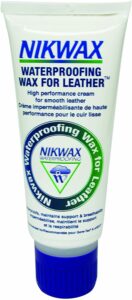
This waterproofing wax by Nikwax is a great product that works instantly and effectively, waterproofing your leather shoes. It doesn’t soften the leather and is really easy to apply as well with the sponge-on applicator. Nikwax waterproofing wax restores water repellency and decreases water absorption of leather. It can be applied to wet or dry leather.
This wax protects the shoes from water but keeps the breathability intact. The product is completely safe, water-based having a biodegradable solution with no harmful solvents like PFCs, VOCs, or optical brighteners; neither is there any added scent. The water-based formula ensures that the wax is concentrated mostly on the spots where there is most leakage on the shoes.
You don’t need to comply with any unpleasant smell either. The best thing about this wax is that it works instantly; there’s no need to wait for hours after every application for it to work. You can apply it at the last minute on clean, washed shoes, no need for them to dry even, and then wipe out the excess.
Pros
- Easy application
- No harmful solvents and scent
- Reduces water absorption
- Water-based formulation
Cons
- Negligible
The Nikwax Waterproofing Wax for leather is formulated to not over-soften the leather. The application is extremely easy, can be applied to either wet or dry leather, no need to wait hours afterward, and it is buildable; you can do multiple coats. Once applied, it works instantly, making your shoe water repellent.
2. Best Spray for Waterproofing: KIWI Camp Dry Water Repellent Spray

The company doesn’t need any introduction; KIWI Camp Dry Water Repellent Spray is one of the best waterproofing sprays you can get. Containing silicone, which binds with leather to form a strong bond and creating a strong water barrier. It is pretty versatile in its usage; it can be used on not just leather shoes but also on non-leather shoes, canvas, and other outdoor items as well.
Along with that, it works on tents, hunting clothes, hiking shoes, and patio furniture as well. While this product will bestow your shoes with excellent water repellent capabilities, it does this without affecting the breathability of the shoes at all. KIWI Camp Dry Water Repellent Spray is specifically manufactured to make sure that the products to which it is applied don’t lose their breathability.
As for the instructions to use, make sure that the shoes, or any other item, is dry and clean before application. Spray from a distance of 7 to 10 inches and cover the entire surface; for more optimal protection, apply a second coat after about 4 hours. It’s best to let the shoes dry for 24 to 48 hours before using them.
Pros
- Contains silicone
- Provides exceptional water-repellency capability
- Applicable on a wide variety of products
- Easy to use
- Maintains breathability
Cons
- Unpleasant smell
- Can leave a slightly darker tone

The spray has easy application and offers extensive usage. The smell it has can grab some disliking by the users though, it smells like cheap paint, which I found pretty strong and which doesn’t go away for long. However, it gets the job done, and it does that brilliantly, offering your shoes strong protection from water, so it’s worth complying with the smell.
3. Best Oil for Waterproofing: Sof Sole Mink Oil
Coming to waterproofing oils for leather shoes, Sof Sole Mink Oil is one of the best picks. It does an excellent job in waterproofing, conditioning, and preserving leather shoes. Not only for leather shoes, but it gets the job done for other leather goods like purses, jackets, hats, and gloves as well, to mention a few.
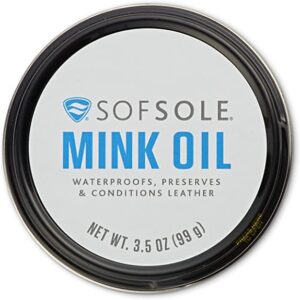
It can protect different types of leather, including tanned, smooth, and full-grain. This oil forms a tough barrier on the shoes that protects them from water. It can make the shoes withstand heavy rains. Besides waterproofing, the oil also conditions and prolongs the life of the shoes. Applying it once every two weeks will increase the durability of the leather shoes.
This oil does really well in moisturizing the leather as well. Its ultra-moisturizing properties will revive the apparently worn-out leather beyond your expectations, adding suppleness to them and keeps them from cracking. Also, you can protect from crease formation with these best crease protectors. The application is easy; use a clean cloth or towel to apply the oil on the leather, wait for a couple of minutes to let it absorb then wipe out the excess.
Pros
- Applicable on a variety of products
- Moisturizing properties as well
- Mild and pleasant smell
Cons
- It darkens the leather a bit
This Sof Sole Mink Oil also has a mild and pleasant smell, hence leaves the products smelling the same. It can darken the leather, so it’s wise to do a patch test first before using it. Other than that, it has excellent conditioning and waterproofing properties, reviving your old leather shoes and extending their durability.
Conclusion
Now you have all the necessary knowledge about the different methods you can use to waterproof your shoes. Along with that, there are recommendations of products that I found among the best. Making your shoes waterproof is not difficult; you have to put some effort into it and be wise about it. You will not find the latter so difficult with the instructions and guidelines provided in this article. So, you have had enough of the water damage to your shoes, grab the waterproofing product of your choice and get it.

